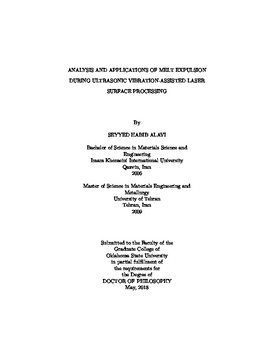| dc.contributor.advisor | Harimkar, Sandip P. | |
| dc.contributor.author | Alavi, Seyyed Habib | |
| dc.date.accessioned | 2019-03-25T21:13:42Z | |
| dc.date.available | 2019-03-25T21:13:42Z | |
| dc.date.issued | 2018-05 | |
| dc.identifier.uri | https://hdl.handle.net/11244/317727 | |
| dc.description.abstract | Simultaneous application of ultrasonic vibrations during conventional material processing is recently gaining widespread attention due to enhancement of material removal mechanism and improvement in metallurgical quality. In addition, application of the high energy ultrasonic vibrations also presents a great potential to facilitate the melt expulsion in the form of sideways melt flow and droplet ejection during the laser melting of material. Such melt expulsion is likely to improve material removal efficiency and surface quality during laser machining of materials. The efficient melt expulsion is also likely to expand the application range of continuous wave CO2 laser into processes such as laser drilling, laser atomization, laser surface texturing, and laser cutting. In this work, the ultrasonic vibration-assisted laser surface processing is proposed in which the effect of simultaneous application of ultrasonic vibration on melt expulsion characteristics during continuous wave CO2 laser surface melting of metallic alloys (AISI 316 stainless steel and Ti6Al4V) is investigated. The application of ultrasonic vibrations during laser surface processing appears to suppress the surface melting due to increasing air flow above the surface and consequent enhancement of surface convection. Moreover, the application of ultrasonic vibrations at higher laser energy densities or longer irradiation times creates well defined craters/holes having resolidified surface films. The geometric features such as hole diameter/depth and aspect ratio of the laser drilled holes are greatly influenced by ultrasonic vibration parameters (frequency and displacement), laser parameters (irradiation time and working distance) and thermo-physical properties of the substrate. The high speed camera (HSC) images of the proposed process indicate that the melt expulsion under the influence of ultrasonic vibrations initiates after the laser melted pool reaches a critical size/volume. In addition, HSC images also reveal that increasing the ultrasonic frequency from 20 kHz to 40 kHz significantly decreases the first droplet ejection time. A multi-step finite element analysis, taking into account the observations of melt expulsion from HSC images, is developed for the prediction of hole volume. Expelled droplets exhibit narrow range of particle size and good circularity which is likely to be used in powder metallurgy applications. | |
| dc.format | application/pdf | |
| dc.language | en_US | |
| dc.rights | Copyright is held by the author who has granted the Oklahoma State University Library the non-exclusive right to share this material in its institutional repository. Contact Digital Library Services at lib-dls@okstate.edu or 405-744-9161 for the permission policy on the use, reproduction or distribution of this material. | |
| dc.title | Analysis and applications of melt expulsion during ultrasonic vibration-assisted laser surface processing | |
| dc.contributor.committeeMember | Kalkan, A. Kaan | |
| dc.contributor.committeeMember | Manimala, James M. | |
| dc.contributor.committeeMember | Vaidyanathan, Ranji | |
| osu.filename | Alavi_okstate_0664D_15636.pdf | |
| osu.accesstype | Open Access | |
| dc.type.genre | Dissertation | |
| dc.type.material | Text | |
| thesis.degree.discipline | Mechanical and Aerospace Engineering | |
| thesis.degree.grantor | Oklahoma State University | |
